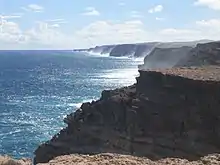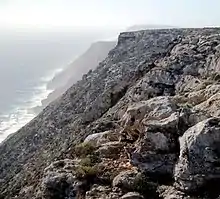

The Zuytdorp Cliffs extend for about 150 km (93 mi) along a rugged, spectacular and little visited segment of the Western Australian Indian Ocean coast. The cliffs extend from just south of the mouth of the Murchison River at Kalbarri, to Pepper Point south of Steep Point. The cliffs are situated in both the Gascoyne and Mid West regions of the state.[1]
At the highest point, near Womerangee Hill, the top of the cliffs are 250 m (820 ft) above the sea.[2] They are named after a trading ship of the Dutch East India Company, the Zuytdorp, that was wrecked against the cliffs in 1712.[3][4]
Geology
The Zuytdorp Cliffs are composed of Pleistocene aged limestone, a formation called the Tamala Limestone.[5] This limestone formed by the cementation of ancient calcareous sand dunes that accumulated near the coast during episodes of the last ice age. It has been inferred that the relatively straight edge of the cliffs is due to a major fault line just off shore.[6]
References
- ↑ West Australian Newspapers (2006), Streetsmart travellers atlas of Western Australia (9th ed.), West Australian Newspapers, ISBN 978-1-921048-13-5 - maps 120/121, showing Shire of Northampton and Shire of Shark Bay boundary occurring just south of both the Zuytdorp wreck, and the Zuytdorp Nature Reserve
- ↑ Playford, Phillip E. (Phillip Elliott) (1958), [Letter of submission dated 15.5.1958 to Nomenclature Advisory Committee giving information on Zuytdorp Cliffs and Womerangea Hill], retrieved 30 December 2013
- ↑ A windswept coast : Western Australia's maritime heritage between the Moore River & the Zuytdorp Cliffs / P. & J. Worsley and D. Totty ; edited by Jeremy Green. Western Australian Museum.Australian National Centre of Excellence for Maritime Archaeology. Fremantle, W.A. : Western Australian Museum, 2008. Special publication (Australian National Centre of Excellence for Maritime Archaeology) ; no. 11.ISBN 9781876465421
- ↑ Playford, Phillip E. (Phillip Elliott) & Western Australian Historical Society (1984). In The wreck of the Zuytdorp on the Western Australian coast in 1712. Royal Western Australian Historical Society, Perth - also, Playford, Phillip E. (Phillip Elliott) (2006). In Carpet of silver : the wreck of the Zuytdorp. University of Western Australia Press, Crawley, W.A ISBN 1-875560-73-4
- ↑ Gordon, Francis Raymond; Curtin University. Department of Applied Geology (2012), Geology of quaternary coastal limestones of Western Australia, retrieved 30 December 2013
- ↑ Hearty, Paul J & O'Leary, Michael J (2008-02-01). Carbonate eolianites, quartz sands, and Quaternary sea-level cycles, Western Australia: A chronostratigraphic approach.(Report). In Quaternary Geochronology. 3 (1-2), 26(30). summary included the following: at the type locality of the Tamala Limestone along the Zuytdorp Cliffs, the upper eolianite-paleosol units are characterized ... [more]by advanced stages of cavernous weathering, pedogenesis, and recrystallization.j
Further reading
- Hocking R.M., van der Graaff W.J.E., Blockley J.G., Butcher B.P. 1982. Ajana, Western Australia, 1:250,000 Geological Map Series, SG50-13, Explanatory Notes, Geological Survey of Western Australia. GSWA download search